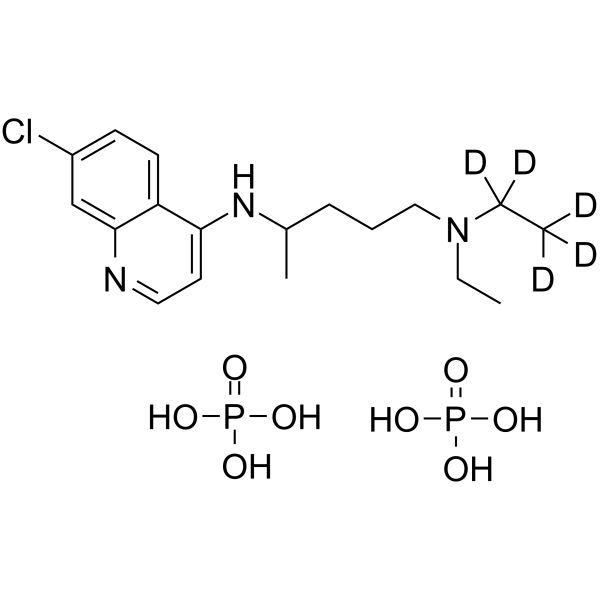上海金畔生物科技有限公司为生命科学和医药研发人员提供生物活性分子抑制剂、激动剂、特异性抑制剂、化合物库、重组蛋白、同位素标记物,专注于信号通路和疾病研究领域。
Chloroquine-d5 diphosphate (Synonyms: 磷酸氯喹 d5 (二磷酸盐))
Chloroquine-d5 diphosphate 是 Chloroquine (phosphate) 的氘代物。Chloroquine phosphate 是一种广泛用于疟疾和类风湿性关节炎的抗疟疾和抗炎剂。Chloroquine phosphate 是 autophagy 和 toll-like receptors (TLRs) 的抑制剂。Chloroquine phosphate 有效抑制 SARS-CoV-2 (COVID-19) 感染 (

Chloroquine-d5 diphosphate Chemical Structure
CAS No. : 1854126-42-3
| 规格 | 是否有货 | ||
|---|---|---|---|
| 100 mg | 询价 | ||
| 250 mg | 询价 | ||
| 500 mg | 询价 |
* Please select Quantity before adding items.
Chloroquine-d5 diphosphate 的其他形式现货产品:
| 生物活性 |
Chloroquine-d5 diphosphate is the deuterium labeled Chloroquine (phosphate). Chloroquine phosphate is an antimalarial and anti-inflammatory agent widely used to treat malaria and rheumatoid arthritis. Chloroquine phosphate is an autophagy and toll-like receptors (TLRs) inhibitor. Chloroquine phosphate is highly effective in the control of SARS-CoV-2 (COVID-19) infection in vitro (EC50=1.13 μM)[1][2][3][4]. |
|
|---|---|---|
| IC50 & Target |
|
|
| 体外研究 (In Vitro) |
Stable heavy isotopes of hydrogen, carbon, and other elements have been incorporated into drug molecules, largely as tracers for quantitation during the drug development process. Deuteration has gained attention because of its potential to affect the pharmacokinetic and metabolic profiles of drugs[1]. Shanghai Jinpan Biotech Co Ltd has not independently confirmed the accuracy of these methods. They are for reference only. |
|
| 分子量 |
520.89 |
|
| Formula |
C18H27D5ClN3O8P2 |
|
| CAS 号 |
1854126-42-3 |
|
| 中文名称 |
磷酸氯喹 d5 (二磷酸盐) |
|
| 运输条件 |
Room temperature in continental US; may vary elsewhere. |
|
| 储存方式 |
Please store the product under the recommended conditions in the Certificate of Analysis. |
|
| 参考文献 |
|
所有产品仅用作科学研究或药证申报,我们不为任何个人用途提供产品和服务
